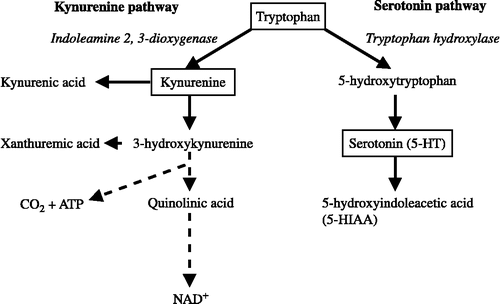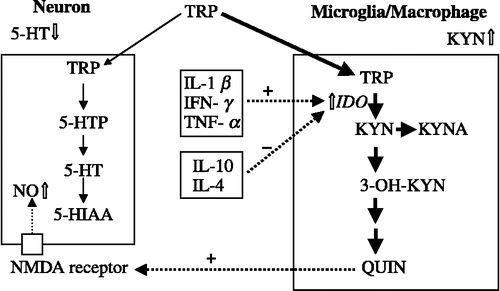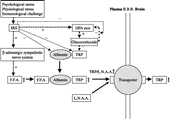Figures & data
Figure 1 Kynurenine and serotonin pathways of tryptophan metabolism. ATP, Adenosine triphosphate; 5-HT, serotonin; 5-HIAA, 5-hydroxyindoleacetic acid; NAD, nicotinamide adenine dinucleotide.

Figure 2 Immunological activation and tryptophan metabolism in the brain. In the macrophages and/or microglia, activated indoleamine 2,3-dioxygenase metabolizes tryptophan. Thus, the kynurenine pathway deprives the serotonin pathway of tryptophan. +, activation; − , inhibition. 3-OH KYN, 3-hydroxykynurenine; 5-HTP, 5-hydroxy tryptophan; 5-HT, serotonin; 5-HIAA, 5-hydroxyindoleacetic acid; IDO, indoleamine 2,3-dioxygenase; IFN, interferon; IL, interleukin; KYN, kynurenine; KYNA, kynurenic acid; NMDA, N-methyl-d-aspartate; NO, nitric oxide; QUIN, quinolinic acid; TNF, tumor necrosis factor; TRP, tryptophan.

Figure 3 Regulation of plasma level and brain uptake of tryptophan. Stress and immune challenges elevate the brain TRP level. Stimulation of the β-adrenergic system increases FFAs. FFAs bind to albumin, releasing TRP from albumin. Increased plasma TRP elevates the TRP/LNAAs ratio. Thus, the transporter system in the BBB for the uptake into the brain selects TRP rather than LNAAs. Another plasma TRP modulation relates to inflammation. The IRS activates the HPA axis to increase glucocorticoids, consuming TRP and other peripheral amino acids to produce plasma-positive APPs and to reduce plasma negative APPs such as albumin that bind TRP. Thus, HPA axis activity may also play a role in the modulation of plasma TRP levels. APPs, acute-phase proteins; BBB, blood–brain barrier; FFA, free fatty acid; HPA axis, hypothalamo-pituitary-adrenal axis; IRS, inflammatory response system; LNAA, large neutral amino acid; TRP, tryptophan.

Figure 4 Regulation of brain KYN pathway and HPA axis by stress and immunological challenges. Stress and immune challenges activate the KYN pathway and the HPA axis. Proinflammatory cytokines activate the KYN pathway via induction of IDO, whereas they stimulate the HPA axis. Furthermore, proinflammatory cytokines attenuate the negative feedback control of the HPA axis. ACTH, adrenocorticotropic hormone; CRF, corticotropin releasing factor; 5-HIAA, 5-hydroxyindoleacetic acid; HPA axis, hypothalamo-pituitary-adrenal axis; 5-HT, serotonin; 5-HTTP, 5-hydroxy tryptophan; IDO, indoleamine 2,3-dioxygenase; IRS, inflammatory response system; KYN, kynurenine; KYNA, kynurenic acid; 3-OH KYN, 3-hydroxykynurenine; QUIN, quinolinic acid; TRP, tryptophan; TPH, tryptophan hydroxylase.
